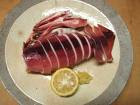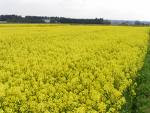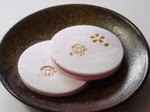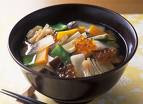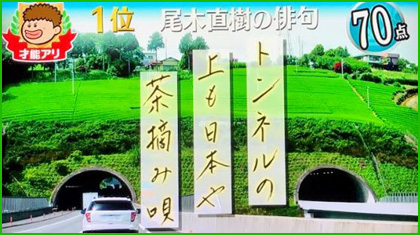::::::::::::::::::::::::::::::::::::::::::::::::::::::::::::::::::::::::::::::::::::::::::::::::::::
Nara Prefecture
Nara Prefecture (奈良県, Nara-ken) is a prefecture in the Kansai region on Honshū Island, Japan. The capital is the city of Nara.
It is certain that a political force established at the foot of Mount Miwa in the east of Nara Basin, seeking unification of most parts in Japan from the third century until the fourth century, though the process was not well documented. At the dawn of history, Yamato was clearly the political center of Japan.
Ancient capitals of Japan were built on the land of Nara, namely Asuka-kyō, Fujiwara-kyō (694–710) and Heijō-kyō (most of 710–784). The capital cities of Fujiwara and Heijō are believed to have been modeled after Chinese capitals at the time, incorporating grid layout patterns. The royal court also established relations with Sui and then Tang Dynasty China and sent students to the Middle Kingdom to learn high civilization. By 7th century, Nara accepted the many immigrants including refugees of Baekje who had escaped from war disturbances of the southern part of the Korean peninsula. The first high civilization with royal patronage of Buddhism flourished in today's Nara city (710–784 AD).
Nara Prefecture is landlocked.
The climate of Nara Prefecture is overall warm, while there are important differences between the north-western basin area and the rest of the prefecture, that is, in the mountains.
. . . CLICK here for Photos !
Nara is famed for its Kaki persimmon. Strawberry and tea are some other popular products of the prefecture, while rice and vegetables, including spinach, tomato, eggplants and others are the dominant in terms of amount of production.
© More in the WIKIPEDIA !
Eight temples, shrines and ruins in Nara, specifically Tōdai-ji, Saidai-ji, Kōfuku-ji, Kasuga Shrine, Gangō-ji, Yakushi-ji, Tōshōdai-ji and Heijō Palace Remains, together with Kasugayama Primeval Forest, collectively form "Historic Monuments of Ancient Nara", a UNESCO World Heritage Site.
Tame deer roam through the town, especially in Nara Park. These deer might not be considered "tame" should the visitor not have any "shika sembei - Deer Biscuits" when they see them.
© More in the WIKIPEDIA ! about Nara City
Mount Miwa (三輪山, Miwa-yama, Miwayama)
Mount Mimoro (三諸山, Mimoro-yama)
. Mount Miwa
Shrine Omiwa Jinja 大三輪神社
:::::::::::::::::::::::::::::::::::::::::::::::::::::::::::::::::::::::::::::::::::::::::::::::::::
Dishes from Nara 奈良の郷土料理

CLICK for enlargement
Asukanabe 飛鳥鍋 hodgepodge from Asuka
Since the year 1400, when Buddhist monks brought the knowledge from China.
Monks considered the milk used here as a kind of medicine to keep healthy in the winter months.
Broth of soy milk or milk with chicken and vegetables. The chicken and vegetables are dipped into beaten eggs before you eat them, like Sukiyaki.
chagayu 大和の茶がゆ rice gruel cooked with tea.
Started in the year 1200 at the hall Nigatsudo at temple Todai-ji, as a simple food for the monks during the O-Mizutori Ceremony.
Now they say
大和の朝は茶がゆで明ける - chagayu
The morning in Yamato starts with a bowl of rice gruel boiled with green tea.
chagayu is used in a variety of cooking, such as Chagayu Kaiseki and Chagayu Bento. It is a simple dish, made of rice, water and tea such as Hojicha or roast tea. As simple as it is, Chagayu is quite popular in Nara due to its refreshing flavor and the way it slips easily down the throat.
. . . CLICK here for Photos !
..... kakimochi iri chagayu かき餅入り茶粥 with kakimochi rice cakes
In summer, this is eaten cold.
Hizen chagayu 肥前茶粥 rice porridge from Hizen Saga prefecture
Iwakuni chagayu 岩国茶がゆ rice gruel from Iwakuni Yamaguchi prefecture
Chagayu from Wakayama, Kumano mountains
Tee-Reisbrei
侘びて澄め月侘斎が奈良茶歌
wabite sume tsuki wabisai ga Naracha uta
. Matsuo Basho, 奈良茶 Naracha rice gruel and Haikai .
chahan, chameshi 茶飯 / 大和茶飯 rice boiled with tea and soy beans
Nara chahan 奈良茶飯
Started in the temples Todai-Ji and Kofuku-Ji, when they added Nibancha (the second brew) with salt to boil rice and beans. Also for the O-Mizutori ceremony.
It is also served now at haiku meetings in Nara. Sometimes black beans are used to boil.
. . . CLICK here for Photos !

dekomawashi
dengaku 田楽 grilled vegetables with miso paste
. . . CLICK here for Photos !
The round ones with radish are also called dekomawashi でこまわし, remembering the round head of bunraku puppets, in the area of Yoshino 吉野地域. Eaten at New Year.
WASHOKU
Dengaku dishes and history
haggeshoomochi 小麦餅(はげっしょう餅) mochi from wheat flour
They are eaten on the day 10 days after the summer equinox, a day called hangeshoo (はんげしょう)半夏生. In the Nara plain, this was a time just after the rice planting, and there was rest to celebrate. Some areas also make it fore the summer festival in July.
. inoko mochi 猪子餅, 亥の子餅
ricecakes in the shape of little wild boars
:::::::::::::::::::::::::::::::::::::::::::::::::::::::::::::::::::::::::::::::::::::::::::::::::::::
KAKI 柿 persimmons
kaki no hazushi かきの葉ずし/柿の葉 葉寿司 sushi wrapped in persimmon leaves
Kakinoha zushi (kakinoha sushi) is one of Nara's delicacies, made of rice seasoned with vinegar and slices of salmon or salted mackerel on top, formed in the shape of a cube, and wrapped with a "kakinoha" or persimmon leaf. Persimmon leaves contain tannin which acts as a natural antibacterial agent. They also contain vitamin C and can help to control high blood pressure. The mackerel used in this food is prepared according to a special method which is kept secret by the people who make it. This is why kakinoha zushi is only available in Nara.
Sushi-Reis umwickelt mit Persimonen-Blättern
kaki namasu 柿なます salad with persimmons
With radish, carrots for an auspicious color effect, and dried persimmons. Especially prepared for the New Year ceremonies in Nara.
. . . CLICK here for Photos !
..... Yamato no tsurushigaki 大和のつるし柿
hanging persimmons from Yamato, they are hung up to dry as winter provisions.
. . . CLICK here for Photos !
An old poem says

色は黒いが味みておくれ、味は大和のつるし柿
iro wa kuroi ga ajimite okure
aji wa Yamato no tsurushigaki
the color is black but just try them -
they taste like dried persimmons from Yamato !
. WASHOKU
kushigaki 串柿 ( くしがき) dried persimmons on a stick
and more about persimmons. Persimonen.
:::::::::::::::::::::::::::::::::::::::::::::::::::::::::::::::::::::::::::::::::::::::::::::::::::::
kashiwa no sukiyaki かしわのすき焼き sukiyaki with chicken
In Memory of Sugaware Michizane on his death day in the end of october, at the shrine in his honor. He is known as the protector of cattle, so instead of using beef for the dish chicken (kashiwa) is used and eaten with all parishioners.
Also eaten on other festive days.
. . . CLICK here for Photos !
konnyaku, kushi konnyaku 串こんにゃく Konjak on skewers
The mountain regions of Yamato Koogen 大和高原 and in the east and south of it, konnyaku roots Konjak are grown.
Devil's-tongue (konnyaku 蒟蒻)
:::::::::::::::::::::::::::::::::::::::::::::::::::::::::::::::::::::::::::::::::::::::::::::::::::::
Yoshino Kuzu from Kurokawa Honke
kuzu ryoori 葛料理 dishes made from arrowroot starch
The root of "kuzu", a plant from the legume family, Pueraria thunbergiana, can be crushed and refined to make starch. This starch is then used to make Kuzu Ryori. Kuzukiri is a semitransparent noodle made from Kuzu; it has a smooth texture and is delicious. Kuzu can also be used as an ingredient in various dishes; for example adding it to tofu or rice cake, makes them chewy and enhances the flavor.
. . . CLICK here for Photos !
Pfeilwurzel.
. . gomadoofu, goma toofu ごま豆腐 tofu made with sesame paste
... kuzu-iri goma doofu 葛入胡麻豆腐 with arrowroot starch
In Yoshino, kuzuku 葛粉 starch of arrowroot is often used.
kuzu くず【国栖/国巣/国樔】 is also the name of a group of people living in Yoshino woods, singing special songs.
kuzu from Yoshino forests "Yoshino kuzu" 吉野葛 is very famous.
Dishes made from Yoshino Kuzu
. . . CLICK here for Photos !
:::::::::::::::::::::::::::::::::::::::::::::::::::::::::::::::::::::::::::::::::::::::::::::::::::::
manyoogayu 万葉粥 rice gruel a la Manyo-shu
Served at the great shrine Kasuga Taisha
With different vegetables every month, according to the poems of the Manyo-Shu 万葉集 poetry collection of the Heian period.
. . . CLICK here for Photos !
Kasuga Taisha 春日大社 was built at the same time as the capital of Nara. It is dedicated to the deity responsible for the protection of the city. Kasuga Taisha was also the tutelary shrine of the Fujiwara clan, Japan's most powerful family during most of the Nara and Heian Period.
. Kasuga Shrine 春日大社 Kasuga-taisha .
Hints of love fill the air at Nara's Manyo festival
Japan's oldest market in Sakurai, Nara Prefecture, will host the Manyo Matsuri on Sept. 8, a festival to commemorate the market and the region's (central Nara Prefecture) ancient culture.
One side of the Hatsuse River used to be the location of an old road that led to the village of Asuka, which was also the capital city of the region during the Asuka Period (593-710). The road intersected with a road to Nanba, today's Osaka. That crossing was a meeting spot for many people and was where the market, known as Tsubaichi, took place.
The ancient Tsubaichi market had an event called the utagaki, which translates as "poem party." During such parties, young men and women gathered and sought out partners by exchanging love poems. Several such poems were included in "Manyoshu," Japan's oldest existing poetry collection, which was compiled some time after the year 759 during the Nara Period (710-794).
Imitating the romantic tradition, festival organizers will sell paper lanterns on which participants can write romantic messages to their loved ones. The lanterns will then be set afloat on Hatsuse River.
source : Japan Times, September 2012
.................................................................................
meharizushi, mehari sushi めはり寿司 rice wrapped in leaves
... toobazushi, tooba sushi とう菜寿司
From the Back Yoshino area 奥吉野, made from wild takana, 高菜, (mana マナ, harumana 春真菜) wrapped around hot cooked rice. It is the first harbinger of spring in Yoshino. Woodworkers and forest workers used it as a bento lunch paket.
The names comes from a wordplay, with "opeinig your eyes wide when seeing this huge lunch paket" "me o miharu hodo okii".
Also eaten in Mie and Wakayama prefecture.
. . . CLICK here for Photos !
..... haru mana no nibitashi 春まなの煮びたし
"cooked spring leaves"
They are first fried in oil and abura-age tofu is added.
Harumana 春真菜 is getting more and more difficult to find in the forests in the Back of Yoshino.
..... haru mana tsukemono 春まな漬 pickled harumana leaves
. . . CLICK here for Photos !
. Takana 高菜 mustard greens .
:::::::::::::::::::::::::::::::::::::::::::::::::::::::::::::::::::::::::::::::::::::::::::::::::::::
Miwa soomen 三輪そうめん / 素麺 thin Somen noodles from Miwa town
Somen are fine dried noodles, only one or two millimeters in diameter. Somen produced in Miwa are known for their high-quality due to the clear air and pure water. Somen have a history of more than 1000 years, showing the Chinese influence on the old capital. They are cooked in boiling water then washed in cold water until they have cooled down. Cooked somen are served with a special soup called somen tsuyu. Adding spice and condiments enhances the taste of the somen. (See nyuumen below.)
momiuri もみうり cucumbers in vinegar
Cucumbers (kyuuri) are rubbed (momi) in salt until they are soft and then pickled in vinegar. The pronounciation then boiled down to momi kyuuri, momi-uri.
Especially eaten in summer. Also prepared at the celebrations after rice planting,to entertain the God of the Rice Fields 田の神.
. . . CLICK here for Photos !
nanairo o-ae 七色お和え dressing in seven colors
Made for the o-Bon celebrations of the ancestors, on August 7, when the preparations begin in the Nara area. Seven vegetables of the season (myooga ginger, taro roots, ingen beans, carrots, eggplants, zuiki, pumpkin and special beans (sando mame 三度豆) are used, different in each family tradition. The dressing is made from sweet miso and sesame. To present it to the ancestors, abura-age tofu is added and cooked rice and steamng hot tea is also pot on the shelf for the ancestors.
Naranoppe, Nara-noppe 奈良のっぺ Noppe vegetable broth from Nara
On the 17th of December at the shrine Kasuga Daisha Wakamiya 春日大社若宮 three is a special festival, On Matsuri おん祭り, where decorations from the passing year are burned as offerings. In Nara, peoople eat NOPPE on this day.
Made of satoimo taro root, radish, carrots and goboo, with aburak-age tofu, a very thick broth to keep you warm.
Narazuke, Nara-zuke 奈良漬け pickled vegetables
Narazuke pickles date back to the 8th Century when Nara was the capital of Japan. They are pickles made from vegetables such as shirouri, a type of cucurbitaceous fruit, using "sakekasu", or sake lees. Nara's "sakekasu" is particularly tasty, and gives the pickles their unique flavor. Narazuke pickles are easily Nara's most famous regional specialty.
nyuumen にゅうめん - 入麺 - 煮麺 - 乳麪 wheat noodles
(a kind of soomen from Miwa)
Their production has been taught by the gods from Mount Miwa to the people living close by. They are thin as a thread, white as snow. They are produced during the cold winter months. In summer eaten cold, in winter in warm broth with seasonal vegetables.
. . . CLICK here for Photos !
sanmazushi, sanma sushi 秋刀魚寿司 sushi from Pacific saury
Around december, this fish comes down from Hokkaido toward the Kii peninsula and is caught near the high sea off Kumano 熊野灘. They have not so much fat and just right for sushi. Often made for family festivities or the new year celebrations.
senbei, shika senbei
Senbei, sembei 煎餅 (せんべい) rice crackers, sweet and salty
shika senbei tobashi, throwing deer senbei, kigo
shikaniku no Yamato-ni 鹿肉の大和煮 boiled deer meat
Meat from wild animals has been eaten since olden times in the villages near the forests around Yamato. Deer has more fat in the summer and autumn months from July to October and is poetically named as Momiji Meat モミジ肉, red maple leaves meat.

shikishiki しきしき snack from wheat flour
Eaten in the Katsuragi Taima area 葛城當麻
Wheat flour is grown on the paddies after the rice harvest. Flour with sugar and eggs is kneaded and made to thin crepes, folded and fried in the pan. It was a treat in times when eggs where an expensive item.
shishinabe しし鍋(しし汁) wild boar soup with miso paste
A lot of winter vegertables are used too, also mountain pepper to appease the strong smell of wild boar meat. The fatty meat warms the body to the bone on a cold winter day in the mountains.
:::::::::::::::::::::::::::::::::::::::::::::::::::::::::::::::::::::::::::::::::::::::::::::::::::::
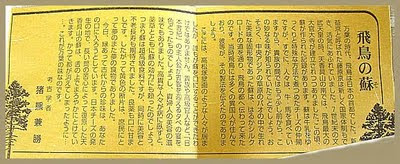
so そ 蘇(そ)酥 / 蘇 milk products of old
from Nara
milk product from boiled down milk of cows or sheep. almost condensed milk.
Made in the the area since the Asuka period (538 to 710 (or 592-645)).
The preparation of milk has been taught to the Japanese from China via the silk road. Since the advent of Buddhism, Emperor Tenmu in 675 made a degree forbidding the use of meat as food. Only wild beasts could be eaten by hunters in the forest. Some monks brought fried bean curd (toogashi とうがし【唐菓子】 ) and milk products like raku らく【酪】 (milk refined for drinking) and so 蘇 (condensed milk), even
daigo だいご【醍醐】 (a kind of butter or cheese), which could be enjoyed instead of meat products.
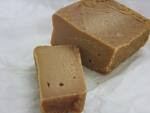
Asuka no So 飛鳥の蘇
daigo 醍醐 is the fifth of our five tasts (gomi 五味). It symbolizes something very much at the top, in Buddhism even satori or enlightenment.
Sweets like a cheese cake made from this old-type milk are sold for example near the shrine Kashihara Jinguu 橿原神宮 in Yoshino.
It almost tasts like caramel candy.
:::::::::::::::::::::::::::::::::::::::::::::::::::::::::::::::::::::::::::::::::::::::::::::::::::::
tachibana 橘 (たちばな) Tachibana citrus fruit
umeboshi 梅干し dried plums, salted plums, pickled ume, plum pickles
After Wakayama and Gunma, Nara is the third largest producer of this daiyl delicacy.
For example from Anou 賀名生 and Tsukigase 月ヶ瀬, where the tradition is very old. The whole family of a plum farmer will be out working in June.
. WASHOKU
Umeboshi 梅干 dried pickled salty plums
. Warabimochi 蕨餅 / 笑来美餅 mochi with bracken powder
Nara is famous for its delicious warabi bracken. These mochi have been prepared since the Ashikaga period.
yakiayu, yaki-ayu 焼鮎 / 焼き鮎 grilled ayu sweetfish
They grow in the clear rivers of Yoshinogawa and Asukagawa 吉野川や飛鳥川 and are already mentioned in the old poetry almanach of the Manyo-Shu 万葉集 .
yakuzen ryoori 薬膳料理 "medicine food", food as medicine
This refers to a healthy cuisine that originated in China. Fresh vegetables produced in Nara, including some that were first brought here from ancient China, are cooked with Japanese herbs and seasonings to create delicious food. Not only is it tasty, yakuzen ryori is also good for enhancing the immune system to keep you in good health. You can try both traditional as well as fusion style dishes.
Yamato mana no nibitashi 大和まなの煮浸し abura-age tofu with vegetables
Yamato mana are the green vegetables of the area. They have quite a sweet taste when boiled. Since Showa 50 some of the wild vegetables are also grown in the mountainous areas of eastern Nara prefecture.
. . . CLICK here for Photos !
yogomi no antsuke-mochi よごみの餡つけ餅 ricecakes with sweet bean paste with mugwort
In the Yamato area, meeting and dining with friends and family in a kind of renzo れんぞ(連座) is on the 3rd day of April.
The most famous RENZO is probably Shinmu Renzo 「神武さんれんぞ」
celebrated at the Shrine Kashiwara Jinguu. Many other temples in Yamato also celebrate on this day.
Farmers do not work on this day and prepare some kinds of food like makizushi and boiled food (nimono) for their relatives as "gosso ごっつぉ" (gochisoo ごちそう/ 御馳走), a feast.
One special dish for this day is yogomi, local dialect for yomogi mugwort. It is picked from the riverbanks, only the young fresh leaves are used. After that day, farmers get busy with the spring field work.
zooni 奈良の雑煮(きな粉雑煮)
New Year Soup with kinako soybean flour
Mochi dumped in sweetened kinako are put in the soup, almost like Abekawa Mochi. Special vegetables, like "yatsugashira" 頭芋(ヤツガシラ)taro roots symbolize the head of a person, tofu stands for the white walls of a storehouse, konnyaku symbolizes a square storehouse with thick brown mortar walls, round mochi help people to live "round" with no problems. The yellow color of the kinako flour brings luck with money matters, the rice grains stand for many children and many generations to follow.
This is quite an auspicious soup !

. . . CLICK here for Photos !
.................................................................................
More specialities
Black Rice Curry
Kaki (persimmon) cake
Masaoka Shiki, a Japanese famous haiku poet wrote a well known haiku "Taking a bite of Kaki, suddenly the bell of Horyuji ringing". This is a Japanese pound cake that uses dried Kaki from Nara.
Nara no Tori Cha (chicken with tea)
Negi ... Home grown Negi and Yamato Nikudori Sukiyaki
Yamato Nabe
Yamato Nikudori Teriyaki Don (Yamato Chicken Teriyaki Bowl)
Sources
http://www.pref.nara.jp/nara_e/dd_aspx_itemid-1388.htm
*****************************
Worldwide use
*****************************
Things found on the way
a snack with no frills
飾らないおやつ

Daruma cookies from Nara
ぜいたく豆本舗
. . . CLICK here for more Photos !
Kukkii だるまクッキーDaruma cookies
Daruma sweets だるまやスイーツ
*****************************
HAIKU and SENRYU
くず水や 花の下ゆく吉野川
kuzumizu ya hana no shita yuku Yoshinogawa
arrowroot water -
under the blossoms flows
the Yoshino river
Kigin 季吟
Kuzu KIGO for summer
:::::::::::::::::::::::::::::::::::::::::::::::::::::::::::::::::::::::::::::::::::::::::::::::::::::
 焼鮎の膳より吹かれ箸袋
焼鮎の膳より吹かれ箸袋yaki-ayu no zen yori fukare hashi-bukuro
blown from the tray
with grilled sweetfish -
paperbag for chopsticks
Katsura Nobuko 桂信子
WKD : Ayu 鮎 trout, sweetfish as KIGO
:::::::::::::::::::::::::::::::::::::::::::::::::::::::::::::::::::::::::::::::::::::::::::::::::::::
Matsuo Basho 松尾芭蕉
staying in Otsu 大津, at the home of Zeze Kyokusui 膳所曲水亭 / 菅沼曲水亭 on September 28.
The theme of the kukai meeting was "yosamu", the evening getting cold.
Basho's host Kyokusui was cooking a night meal of wheat noodles, miso, and vegetables.

乳麪の下たきたつる夜寒哉
煮麺の下焚きたつる夜寒哉
nyuumen no shita takitatsuru yosamu kana
beneath the noodles
building up the fire:
the night's cold
Tr. Barnhill
noodles
building a fire underneath
a night's cold
Tr. Reichhold
Written in autumn of 1691, 元禄4年晩秋
This hokku has the cut marker KANA at the end of line 3.
tending to a fire
beneath the hot wheat noodle soup
on this cold night . . .
Tr. Gabi Greve
. Matsuo Basho 松尾芭蕉 - Archives of the WKD .
*****************************
Related words
***** WASHOKU : Regional Japanese Dishes
- #nara #chagayu -
:::::::::::::::::::::::::::::::::::::::::::::::::::::::::::::::::::::::::::::::::::::::::::::::::::





